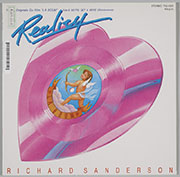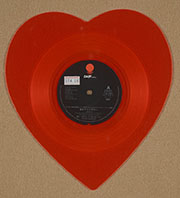70th Anniversary Commemorative Exhibit "A Treasure Box of Books - The 70-year History of the National Diet Library and Its Collections"
- A Treasure Box of Books
- Part 2 Diverse Collections
- Chapter 3 Books depicting society of the day
- Section 3 Changing recording media
Part 2 Chapter 3 Section 3 Changing recording media
The National Diet Library also collects audio and video materials. This section features exhibits on materials related to historical events such as the games of the 1964 Tokyo Olympics and the Apollo 11 moon landing. It also exhibits changes in the media used to capture these events.
123 Kotaishisama Omedeto - Yasashii Purinsesu (Congratulations Prince - The Kind Princess), Teichiku 1959 [YMA-4-30-9]
SP records are made of a natural resin called shellac and can record up to a maximum of 4 minutes and 30 seconds of sound per side.
The domestic production of SP records began in 1907 and ended in 1963. The exhibited material is a picture record created in April 1959 in commemoration of the crown prince's (Emperor Emeritus Akihito's) wedding.
124 Ai no Fantajii (Reality), Toshiba, 1982 [YMA-267-19-2]
Normally, records include carbon in order to strengthen and color them, so they are black, but color records contain red, blue, or other pigments. The exhibited material is a heart shaped color record of the main theme of the worldwide hit French movie La Boum that was released in 1980.
125 Asahi Sonorama 116, Asahi Sonorama,[YMH-15]
Sonosheets are thin, inexpensive records made of vinyl chloride, which were used as supplements for magazines. They were produced within Japan from 1959 to 2005. Asahi Sonorama was a magazine published in 1973 which included a sonosheet record. The exhibited material includes recordings of communications with the astronauts of the Apollo 11, launched on the July 16, 1969.
126 Tokyo Orimpic -NHK hoso yori-, Columbia, 1965 [YMA-55-9-6; YMA-55-9-10]
LP records were polyvinyl chloride records which could record up to 30 minutes of audio per side. Sales of the records began in Japan in 1951, and production in Japan reached its peak in 1970. The exhibited materials are a set of five records which were edited from the NHK live broadcast tapes of the games of the 1964 Tokyo Olympics and from broadcast tapes of the programs broadcast after the events were over.
127 OHTAKI Eiichi - A Long Vacation, Sony, 1982 [YMC-2-4-7]
CDs (compact discs) were optical discs for recording audio which stored digital data and a 12 cm diameter CD could record approximately 74 minutes of audio. In October 1982, the first sales of CD players and CDs in the world began in Japan. The exhibited material is the first CD produced by Sony in Japan.
128 Salad Classic (1) Strawberry, Sony Records, 1988 [YMCB-8-7-23]
8 cm diameter CDs (compact discs) which began being sold in 1988 could record approximately 22 minutes of audio. These were used to present new songs as single CDs, but were replaced by 12 cm single CDs and were rarely sold after 2009. The exhibited material is one of the 8 cm Classic CDs sold in Japan.
129 Fushicho, MISORA Hibari, Nippon Columbia, 1992 [YMC31-805]
MD (Mini Discs) were a type of audio recording media consisting of approximately 6.4 cm diameter optical discs housed in a cartridge. Sales of MD players began in 1992, and MDs with music began being sold by various companies within Japan around the same time. The exhibited material is the MD version of Misora Hibari's album announced after her recovery from an illness in 1988.


